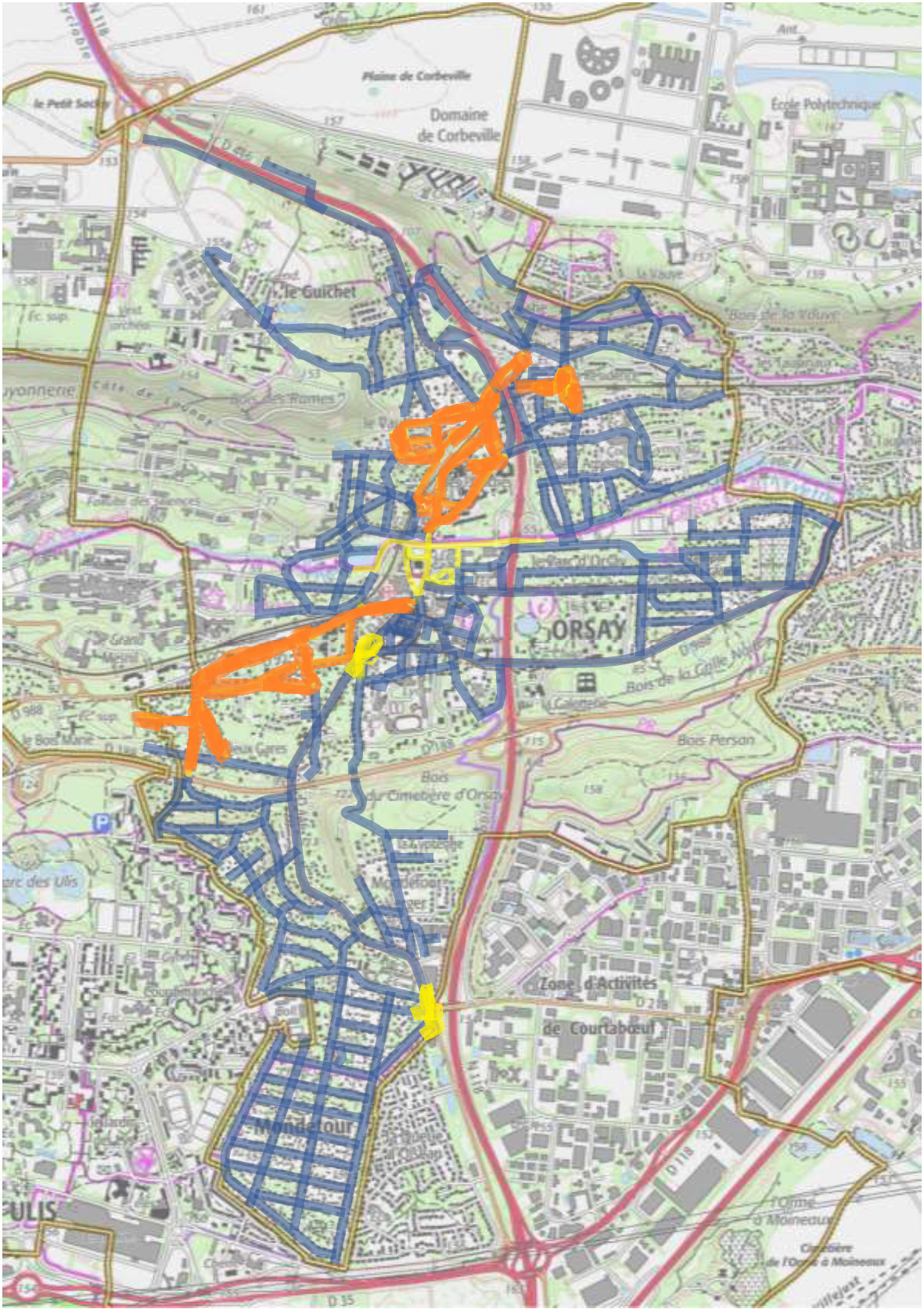How did this project start?
More than a third of french towns are proceeding to total shut-off of public lighting during the night. In April 2020, Orsay chooses to experience an extinction of the lights in specific areas and at specific hours, enjoying the reduction of RER Bs (due to covid-19 restrictions).
At the end of the experimentation, as Orsay was committed, however taking into account the different comments and opinions of the population, the town provided a modification in the hours of public lighting extinction, following the return to normal of RER B schedules, and the return to work of a growing number of Orcéens.
What are the modalities of this experiment?
The territory of the municipality remains divided into three zones (see map below) with the following new timetables (from April 2020): 
- Yellow Zone : proximity to the hospital, and night bus service areas (in yellow).
(access to Hospital via N118, République and Mondétour bus stations): The lights stay on all night.
- Orange Zone : near the train stations (in orange). The night lighting is off from 1:30 a.m. to 5 a.m. all the time
- Blue Zone : residential areas. The lights are off from midnight to 5 a.m. Sunday to Thursday and from 1:30 a.m. to 6:30 a.m. Friday to Saturday.
In more details:
- Night from Sunday to Monday: Midnight - 5 a.m.
- Night Monday to Tuesday: Midnight - 5 a.m.
- Night Tuesday to Wednesday: Midnight - 5 a.m.
- Night Wednesday to Thursday: Midnight - 5 a.m.
- Night Thursday to Friday: Midnight - 5 a.m.
- Night Friday to Saturday: 1h30 a.m. - 6:30 a.m.
- Night Saturday to Sunday: 1h30 a.m. - 7h00 a.m.
Please note that special treatment of shutdown times will be concerning certain areas such as stairs, undergrounds, etc..
- All the city is lighted all night for Christmas and boxing day, New Year, 21th June (national music festival) and Bastille day.
- All the city is totally (except the Yellow zone) in the dark once a year for the night of the stars.
What is the point of such a device?
- First of all, it will allow a significant reduction in the municipality's electricity bill: the calculation will be fine-tuned but could amount to savings of 45%, which would represent an annual gain of € 100,000 for municipal finances.
- Road safety studies prove that vehicles tend to reduce their speed in areas with no lights, thereby reducing the risk of accidents and noise pollution due to their passage.
- On the other hand, many studies have now clearly established that several animal species (birds, insects, bats, etc.) suffer from permanent lighting which is probably one of the factors explaining the collapse of certain animal populations, and the alarming decline of biodiversity;
- Finally, this extinction allows a better quality of night sleep and thus protects the health of Orcéens, because the day/night alternation is essential to the quality of the biological rhythms of humans. To be healthy, this rhythm must be respected and extinction contributes to it.
Does this extinction have consequences in terms of security?
- The increase in robberies has been reduced by the experience of municipalities that have already implemented night-time extinguishing. Indeed, most crimes are committed during the day, and these municipalities have not seen an increase in night-time robberies;
- The risks for a pedestrian of being hit by a motor vehicle are reduced in an unlit street due to the reduction in speed caused by poor visibility;
- When traveling for pedestrians during the extinction period, it may be more comfortable to bring a flashlight, a headlamp, or a mobile phone lamp, except on a clear night with a full moon of course.
How will the project continue?
- The modernization of the lighting system will continue: a multi-year plan has led the municipality to change the lamps of the candelabra for LED lamps, some of which are at modular power (at night, the brightness is greatly reduced), and others are triggered by radar. The electrical cabinets were equipped with “astronomical” clocks to optimize the lighting and extinction of the candelabra throughout the seasons.
- In addition, Orcéens will be invited to reflect on this system as part of a citizen consultation in the second half of 2020, the terms of which remain to be defined.
To go further in the reflection
- https://www.darksky.org/ (English)
Alll others in French:
- Sophie Mosser, thesis and article (FR)
- An ADEME guide on light pollution (in particular pages 22 and 23 on safety) (FR)
- An article from ReporTerre (FR)
- The Nuit France website (FR)
- The Local Solutions website (FR)
- The opinion of the International Astronomical Union (FR)
- An article from the newspaper Le Monde (FR)
- A book: Éclairer la ville autrement, Jean-Michel Deleuil (editor), EPFL Press (FR)
















